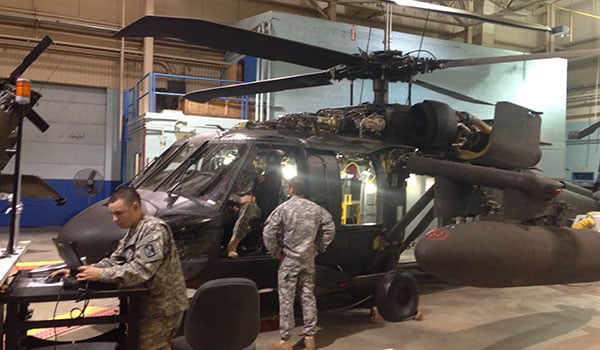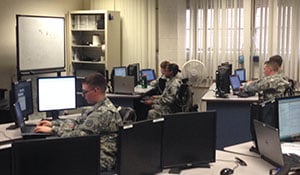
128th Aviation Brigade Update / By CPT Andrew T. Freeman: For this issue, I’ve asked our C/1-210th Aviation commander, CPT Freeman, to provide some insight as to how your school house uses a wide array of simulators and simulations to produce realistic and safe training. “Above the Best!” COL Rigole, Commander

IMI and computer simulations provide an important bridge from the classroom to hands-on instruction. / 128th AVN BDE GRAPHIC
Competent and qualified aircraft maintainers are not born, they are bred out of the regimented training courses at the 128th Aviation Brigade at Joint Base Langley-Eustis, Virginia.
Advanced Individual Training (AIT) in the 128th follows a rigorous and structured program which reflects the Army’s training methodology of crawl, walk, run. This process produces Soldiers that are ready to begin practicing their craft on Army aircraft with the supervision and guidance of unit leaders in support of the Aviation mission.
The AIT blocks of instruction are divided into conference (lecture-based instruction), Interactive Multimedia Instruction (IMI, computer-based instruction), and hands-on training utilizing Virtual Immersive Environment (VIE) technology and high fidelity trainers. The use of simulation in training is necessary because it provides a bridge between classroom instruction and real world operations, increases realism in training, and provides a safe training environment in which to train new Soldiers.
Learning by Doing
Although conference instruction is a necessary part of training, it is not sufficient for complete skills transfer from instructor to student. During conference instruction, Soldiers are given the basic theory for, and description of, aircraft systems, maintenance tools and techniques. This knowledge transfer is essential to building a foundation for learning; however, it is not in itself sufficient to build the skills necessary to create competent Soldiers.
Soldiers practice the skills and knowledge gained in conference instruction by applying those fundamentals to a computer-based simulated environment in an IMI program. If conference is the crawl stage of training, IMI is the walk phase. This training compels Soldiers to begin to think for themselves through real-world problems, while allowing for self-paced learning and additional instructor supervision.
 Students use high fidelity trainers to increase realism in training.The VIE and high-fidelity training devices are the final step in any block of instruction for aircraft training. In this, the run phase, Soldiers are required to exercise critical thinking to solve problems that they will encounter in operational units. The experience these Soldiers receive from the training devices is invaluable and provides the final bridge to the real-world unit. This gradual increase of realism and intensity in training would not be possible without the use of simulations.
Students use high fidelity trainers to increase realism in training.The VIE and high-fidelity training devices are the final step in any block of instruction for aircraft training. In this, the run phase, Soldiers are required to exercise critical thinking to solve problems that they will encounter in operational units. The experience these Soldiers receive from the training devices is invaluable and provides the final bridge to the real-world unit. This gradual increase of realism and intensity in training would not be possible without the use of simulations.
Hands-On Realism
Realism is of high importance in AIT. Soldiers must not only be given realistic situations to practice, but must also have realistic equipment to support those situations. A Soldier can be told what it feels like to disconnect a hard-to-reach canon plug or what a torque wrench feels like when it finally “pops,” but none of those explanations are a substitute for first-hand knowledge. This knowledge can only be ingrained through hands-on experience. Simulated training environments accomplish this objective by giving Soldiers the ability to touch tools and components that recreate real life without requiring instructors to break real aircraft systems.
Training Aids, Devices, Simulators and Simulations (TADSS) give the AIT instructor a reliable way to consistently recreate real-world problems and to monitor a Soldier’s performance. With these capabilities, instructors can create more realistic training that is geared toward identifying and improving Soldier weaknesses to produce a more well-rounded aviation maintainer.
By practicing on these trainers, Soldiers gain an understanding of what “right” really looks like. They may increase the efficiency of their unit’s maintenance through familiarity with component locations and functions learned from thorough training on accurately modeled devices. Some Soldiers even learn how to read the Technical Manuals better with hands-on comparison to mock devices, rather than through the visualization required in classroom instruction. Each individual Soldier benefits from the simulators differently, but they all benefit from the realism of the training aids.
 An AIT instructor walkes a student through IMI simulations.Safe and Effective
An AIT instructor walkes a student through IMI simulations.Safe and Effective
While realism is important, it can also be dangerous; safety remains of the utmost importance. Aviation is incredibly unforgiving, uncorrected mistakes can be fatal. TADSS, however, are forgiving, allowing some latitude with respect to critical errors. Simulators are equipped with a variety of safeties, such as emergency stop buttons, built-in catwalks, and monitoring software. These safety measures allow for Soldiers to feel secure in conducting their tasks by providing an environment free of dangerous distractions, enabling instructors to allow Soldiers to learn from their mistakes without fear of harm.
Soldiers are always expected to maintain complete safety awareness and are evaluated on following safety practices, but lapses in safety do not pose the same risk that they would while working on real aircraft.
In order for Soldiers to become fully trained in their field and successfully maintain Army aircraft, they must be built from the ground up. Soldiers from all backgrounds, from high school students to ranch hands to electricians, must be taught the fundamentals of their Army profession.
Classroom instruction is simply not enough to fulfill that requirement and TADSS are a necessary means to meet the demand. Training devices and simulations provide bridges for Soldiers to cross as they travel through the Army’s crawl, walk, and run phases of training by gradually leading them from conference to hands-on instruction. The increased realism allowed by simulations in training prepares them for real-world situations when they begin working at their units.
The safe environment created through simulations allows learning from mistakes with reduced risk. The result is a well-rounded, qualified aviation mechanic with the skills necessary to become an apprentice in their craft.
CPT Andrew T. Freeman is the commander of Company C, 1st Battalion, 210th Aviation Regiment, 128th Aviation Brigade, Joint Base Langley-Eustis, VA.










